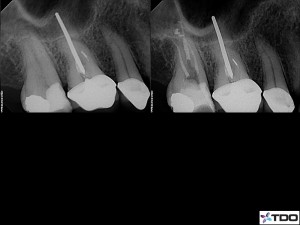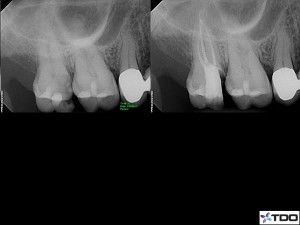Customarily, upon the completion of endodontic therapy, a provisional restoration is placed. The patient is then returned to the general dentist for the placement of a definitive restoration. So after all of the isolation and disinfection we have established and maintained during the endodontic phase of treatment, we now place the integrity of our root fillings in the “hands” of a provisional restoration.
Coronal leakage is real. Saliva is chock full of bacteria and the leakage of microorganisms into the canal system can cause failure. We know for a fact that steps we can take to minimize leakage will improve our success rates. While we are under rubber dam isolation in a magnified and illuminated field, what can be done to minimize leakage into obturated canals?
- Orifice barriers.
- Placement of definitive restoration/Core Buildup/Post and Core
- Calcium Hydroxide(As a canal backfill when a post space is created)
Here are two upper second molars recently treated in my practice. Both cases appear acceptable radiographically, but the coronal endodontics couldn’t be more different.
Here is the question: Why haven’t we, as a profession(dental, not endodontic or general, but solely dental), moved towards instituting the above measures as a matter of routine to minimize postoperative leakage after the completion of endodontic therapy?
And I haven’t forgotten that I didn’t address the doctors who referred the final two cases from my last post. I’ll make sure I address them in the next installment.

